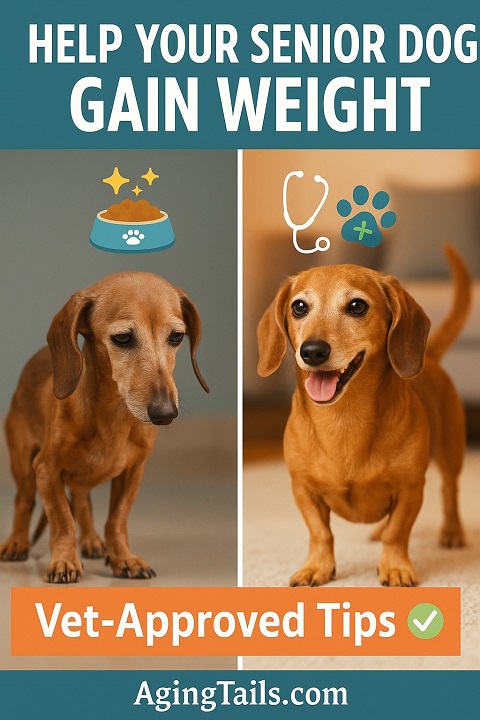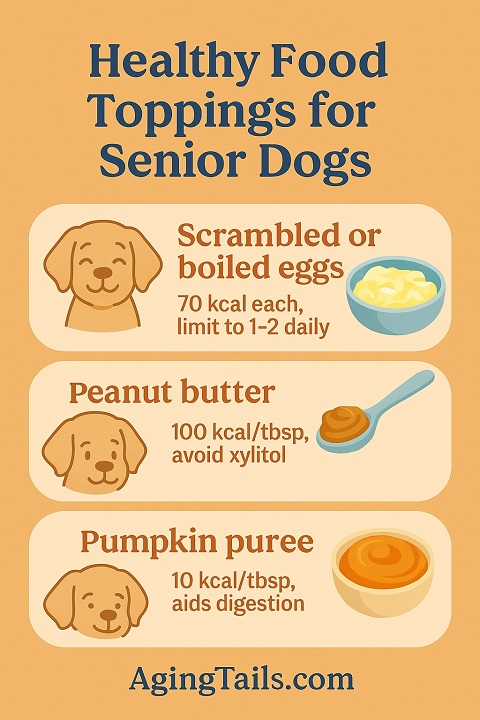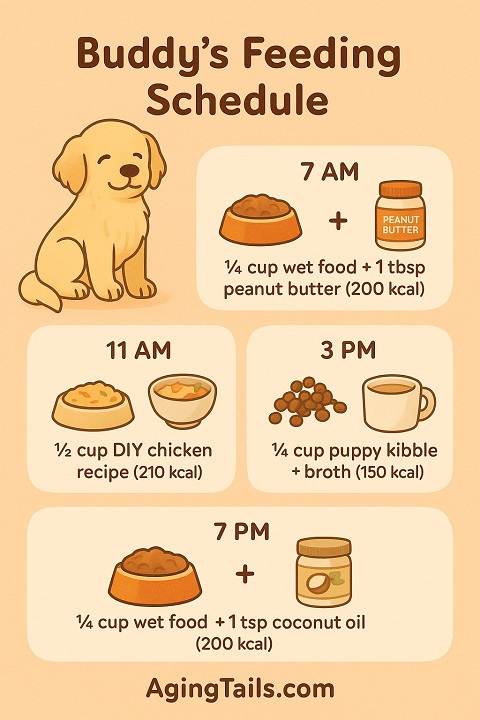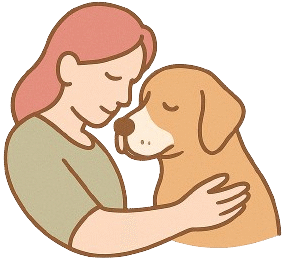Watching your senior dog struggle to maintain weight can be heartbreaking. You might notice their ribs showing, a lack of energy, or a once-wagging tail now hanging low. For pet owners, the urgency to help an aging dog gain weight fast—while keeping them safe—is a top priority. If you’re looking for a complete guide to help senior dog gain weight fast then you’re at the right place.
Weight loss in senior dogs is common, but it’s not something you have to accept. This guide offers vet-approved, actionable strategies to help your older dog pack on pounds quickly and healthily, addressing both physical and emotional challenges.

From high-calorie diets to feeding tricks, we’ll cover everything you need to know to restore your dog’s vitality. Whether you’re dealing with senior dog weight loss or searching for ways to help an older dog gain weight, this article is your go-to resource for practical solutions tailored to pet owners.
Why Senior Dogs Lose Weight
Senior dogs often lose weight due to a combination of physical, medical, and emotional factors. Understanding the root cause is critical before starting any weight gain plan.
“Many older dogs lose weight due to chronic diseases or dental issues that make eating painful” – Dr. Dorothy P. Lafflame
Here are the most common reasons, along with insights into behavioral factors often overlooked by other resources:
- Medical Conditions: Dental disease, kidney disease, cancer, diabetes, and hyperthyroidism can reduce appetite or impair nutrient absorption. For example, dental pain affects 80% of dogs over age 3, making chewing difficult. Cachexia, a severe muscle-wasting condition linked to chronic illnesses like cancer, is another culprit.
- Reduced Metabolism: Aging dogs have slower metabolisms, requiring fewer calories but higher-quality nutrients. This can lead to unintentional weight loss if their diet isn’t adjusted.
- Appetite Changes: Senior dogs may lose interest in food due to reduced taste or smell, medication side effects, or nausea from health issues.
- Behavioral/Emotional Factors: Stress from household changes (e.g., a new pet, moving), grief from losing a companion, or anxiety can suppress appetite. These emotional triggers are rarely addressed but can significantly impact eating habits.
Common Causes of Weight Loss in Senior Dogs
| Condition | Symptoms | Vet Action |
| Dental Disease | Bad breath, difficulty chewing | Dental cleaning, extractions |
| Kidney Disease | Increased thirst, weight loss | Blood tests, dietary changes |
| Cancer/Cachexia | Muscle loss, lethargy | Diagnostic imaging, treatment plan |
| Stress/Grief | Reduced appetite, withdrawal | Behavioral assessment, calming aids |
Pro Tip: Schedule a vet visit to rule out medical issues. Share observations about your dog’s behavior, such as changes in household dynamics, to uncover emotional causes.
Assessing Your Dog’s Weight Needs
Before starting a weight gain plan, determine if your senior dog is underweight and set a target weight. The Body Condition Score (BCS) and Muscle Condition Score (MCS) are vet-recommended tools for this.
- Body Condition Score (BCS): A 9-point scale where 1 is emaciated and 9 is obese. For weight gain, aim for a BCS of 4–5 (ribs felt with slight fat cover). Download a BCS chart to assess at home.
- Muscle Condition Score (MCS): Evaluates muscle mass, crucial for senior dogs prone to muscle loss. Check for wasting around the spine, hips, and shoulders.
- Calorie Needs: Senior dogs need 20–30 calories per pound of ideal body weight daily, adjusted for activity and health. For example, a 20-pound dog may need 600–800 calories to gain weight.
- Calorie Calculation Example:
- Small Breed (10 lbs, ideal weight): 300–400 calories/day.
- Medium Breed (30 lbs, ideal weight): 900–1,200 calories/day.
- Large Breed (60 lbs, ideal weight): 1,800–2,400 calories/day.
Action Step: Use a BCS chart and consult your vet to set a target weight. Calculate daily calories based on your dog’s ideal weight and adjust as needed.
How to Help Senior Dog Gain Weight Fast
To help your senior dog gain weight fast, combine dietary changes, supplements, feeding techniques, exercise, and environmental adjustments.
Dietary Changes
A high-calorie, nutrient-dense diet is the cornerstone of rapid weight gain. Focus on foods that are high in protein, moderate in fat, and highly digestible to support senior dogs’ sensitive systems.
“Senior dogs need highly digestible, protein-rich foods to support weight gain without taxing their system” – Dr. Brandon Stapleton
Commercial Foods:
- Wet Food: More palatable and digestible than dry kibble. Try Hill’s Prescription Diet a/d (critical care food) or Royal Canin Recovery, both vet-recommended for weight gain. For small breeds, explore our guide to soft dog food for small senior dogs for tailored options.
- Puppy Food: Higher in calories and protein, suitable for healthy senior dogs.
- Fresh Food: The Farmer’s Dog offers high-protein, human-grade meals tailored for senior dogs.
DIY Recipes (Budget-Friendly):
- Chicken and Rice Meal: Boil 1 cup chicken breast (200 kcal), ½ cup white rice (100 kcal), and 1 tbsp olive oil (120 kcal). Yields ~420 kcal per serving. Add a pinch of pumpkin puree for digestion.
- Beef and Sweet Potato: Combine 1 cup ground beef (300 kcal), ½ cup mashed sweet potato (100 kcal), and 1 tbsp fish oil (100 kcal). Yields ~500 kcal.
Safe Human Foods:
- Eggs (70 kcal each): Scrambled or boiled, limit to 1–2 daily.
- Peanut butter (100 kcal/tbsp): Spread on food, avoid xylitol.
- Pumpkin puree (10 kcal/tbsp): Aids digestion, mix into meals.

Supplements
Supplements can boost calorie intake and support overall health. Always consult a vet before adding them.
- Omega-3 Fatty Acids: Support coat, joints, and appetite.
- Coconut Oil: Adds 120 kcal/tbsp and supports digestion. Start with ½ tsp daily.
- Probiotics: Improve gut health, aiding nutrient absorption.
- Holistic Options: Herbal appetite stimulants (e.g., ginger, under vet guidance) or acupuncture can boost appetite in resistant cases. Research holistic vets in your area via AHVMA.
Feeding Techniques
How you feed your dog is as important as what you feed. These techniques maximize intake and palatability.
- Smaller, Frequent Meals: Offer 4–5 meals daily to increase calorie intake without overwhelming the stomach. Example: A 20-pound dog needing 800 kcal/day gets 200 kcal per meal.
- Food Toppers: Add low-sodium broth, gravy, or Stella & Chewy’s Meal Mixers (available at Chewy) to enhance flavor.
- Warm Food: Heat wet food to 100°F to release aromas, enticing picky eaters.
- Sample Feeding Schedule:
- 7 AM: ¼ cup wet food + 1 tbsp peanut butter (200 kcal).
- 11 AM: ½ cup DIY chicken recipe (210 kcal).
- 3 PM: ¼ cup puppy kibble + broth (150 kcal).
- 7 PM: ¼ cup wet food + 1 tsp coconut oil (200 kcal).

- Distraction-Free Environment: Feed in a quiet area to reduce stress, especially for anxious dogs.
Exercise and Appetite Stimulation
Gentle exercise builds muscle and stimulates appetite, a strategy competitors often overlook.
- Short Walks: 10–15 minutes twice daily, adjusted for mobility. Use a harness to reduce joint strain.
- Swimming: Low-impact exercise for arthritic dogs. Check local pet pools via DogPools.
- Sample Exercise Plan:
- Day 1–3: 5-minute walk, 5-minute massage to stimulate circulation.
- Day 4–7: 10-minute walk, 5-minute gentle play (e.g., soft toy fetch).
- Week 2: Add 5-minute swimming or stair steps if able.
Environmental Adjustments
Make eating easier for senior dogs with sensory or mobility issues.
- Elevated Bowls: Reduce neck strain for arthritic dogs.
- Non-Slip Mats: Prevent slipping during meals, ideal for dogs with weak legs.
- Brightly Colored Bowls: Help dogs with vision loss locate food. Use red or yellow bowls.
- Hand-Feeding: For dogs with hearing loss or severe weakness, hand-feed small portions to encourage eating.
- Comfortable Resting Area: A supportive bed can improve overall well-being, aiding appetite. Check our recommendations for the best dog bed for senior dogs to ensure your dog rests comfortably.
Monitoring Progress and Avoiding Pitfalls
Track your dog’s progress to ensure safe weight gain and avoid health risks.
- Weekly Weigh-Ins: Use a pet scale or weigh yourself holding your dog. Aim for 0.5–1% body weight gain weekly (e.g., 0.1–0.2 lbs for a 20-pound dog).
- Adjust Calories: If no gain after 2 weeks, increase calories by 10% with vet approval.
- Pitfalls to Avoid:
- Overfeeding: High-fat diets can cause pancreatitis. Limit fat to 15–20% of calories.
- Rapid Changes: Switch foods gradually over 7–10 days to prevent digestive upset.
Pro Tips for Owners
Caring for an underweight senior dog can feel overwhelming, stirring guilt or fear about their health. You’re not alone—many USA pet owners share this journey.
Take Sarah from Texas, who helped her 12-year-old Lab, Murphy, gain 5 pounds using DIY meals and frequent feeding. “It was stressful, but seeing him wag his tail again was worth it,” she says. Here are tips to cope:
- Journal Your Experience: Write daily notes about your dog’s progress to stay hopeful.
- Join Support Groups: Connect with others on Reddit’s r/DogAdvice or senior dogs-based forums.
- Consult a Pet Counselor: Find professionals for emotional guidance.
Conclusion
Helping your senior dog gain weight fast is achievable with the right strategies. Start with a vet visit to rule out health issues, then use high-calorie foods, supplements, feeding tricks, and gentle exercise to restore their vitality.
Don’t forget to care for yourself—your love and dedication make all the difference. Share your story in the comments below or subscribe for more senior dog care tips. Let’s help your furry friend thrive!
FAQs
What foods help senior dogs gain weight?
High-protein, high-fat foods like wet food, puppy kibble, or DIY meals (chicken and rice) are ideal. Add safe human foods like eggs or peanut butter in moderation.
Can I feed my senior dog human food?
Yes, in small amounts. Eggs, peanut butter, and pumpkin are safe and calorie-dense. Avoid toxic foods like grapes or onions.
How fast should my senior dog gain weight?
Aim for 0.5–1% of body weight weekly (e.g., 0.1–0.2 lbs for a 20-pound dog) to ensure safe, steady gain.
